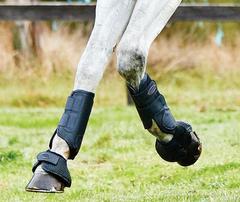 You’ve probably noticed that some horses wear boots or bandages on their lower legs when ridden. Although they can provide some minimal support to the horse’s tendons and ligaments, boots and bandages are primarily used for protection of the horse from himself. If you want to use something on your horse's legs, it can be confusing to figure out what to use and when.
You’ve probably noticed that some horses wear boots or bandages on their lower legs when ridden. Although they can provide some minimal support to the horse’s tendons and ligaments, boots and bandages are primarily used for protection of the horse from himself. If you want to use something on your horse's legs, it can be confusing to figure out what to use and when.
Sometimes a horse needs to be protected from himself. Because of his conformation, his hind legs may brush against each other or he may even kick himself when he is cantering. Or a horse with a long stride can accidentally step on the back of his front feet at the trot. While a horse’s hoofs can cause damage, those shod with metal horse shoes can cause a severe gash or bruise. And a horse does strenuous work that involves jumping or sudden stops and starts, boots or bandages may help protect the delicate tendons in his legs from stress or injury.
But, not all horses require wearing boots. Many new riders put on wraps or boots because everyone else seems to be doing it. If you don't ride your horse in high-risk movements or if your horse doesn’t seem to have an issue with scrapes or cuts, you can leave off the protective wrapping. If you don't know if you should put protective gear on your horse's legs, ask a knowledgeable instructor what she thinks. Explain the sort of work you do with your horse and let her take a look at his conformation. An experienced instructor will be able to tell if your horse needs boots or bandages. And, more importantly, she will show you the proper way to put them on. Improperly applied boots and bandages can actually do more damage than good.
Some of the more common wraps for legs are:
Splint Boots (Brushing Boots)
Splint boots have a thick and/or hard plate that covers the inside of a horse's lower leg. The plate protects a horse when he hits the inside of one leg with the opposite hoof. When a horse hits himself with the other hoof, it can cause nasty cuts on the inside of the leg. These cuts may take a long time to heal. Splint boots are probably the most widely used boots by horse people.
When putting a splint boot on, fit it slightly higher around the leg, then slide it down so the leg hair doesn't get ruffled up and cause rubs. Many people fasten the bottom strap first so the boot doesn't slip while you are securing it.
Bell Boots (Over-Reach Boots)
Bell boots sit on the bottom of the horse's foreleg, around the coronary band at the top of the hoof. They are designed to fit the contours of the pastern and heel area. Bell boots are used on the front hooves and they help protect the front heels from getting nicked by the back hooves. Bell boots are made of rubber or stretchy material. Some have to be pulled on over the hoof and others have Velcro fastenings. They should not be so long that your horse trips over them or they interfere with his movement. Correct sizing is important.
Exercise Bandages or Polo Wraps
Exercise bandages are stretchy wraps that give support to the tendons in a horse's lower legs. They tend to be used when a horse is in strenuous work, or if he has suffered from tendon problems in the past. They are wrapped around the lower leg, and are usually secured with a Velcro strap.
Putting on a bandage properly is a skill that takes time to learn. If the bandage is not stretched out properly with the right tension or if it is wrapped incorrectly, it could hurt your horse's leg instead of supporting it. Ask an instructor to show you how to wrap a leg and then practice, practice, practice until you get it right.
Sports Medicine Boots
Sports Medicine boots were developed specifically to address the prevention of suspensory injuries while at the same time protecting the soft tissue from cuts, abrasions and contusions caused by impacts to the legs by hooves and various other hazards. They can be used on all four legs and consist of a neoprene-type material to provide cushioning and are secured with a Velcro strap that helps provide support.
Remember to use the right support at the right time to keep your horse happy and healthy.
<span style="color:#000000;">Photo credit: Weatherbeeta</span>



